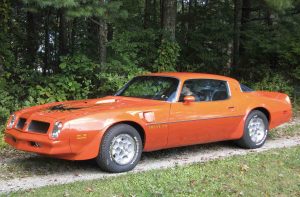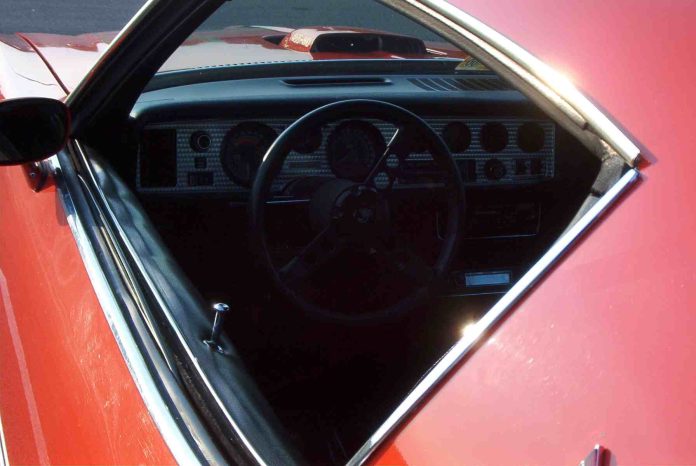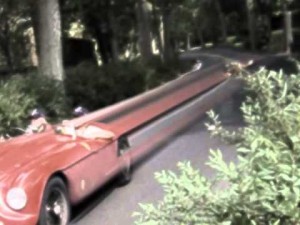Imagine if you had to use a scan tool to figure out why your toilet won’t stop running. You don’t have to do that, of course, because it’s a purely mechanical device and so there’s nothing to scan but much you can see. The float might be stuck, for instance. So you jiggle it free and the toilet stops running.
Cars used to be like this, too – before they became moving computers on the road to becoming mobile devices that require apps as well as scans.
My Orange Barchetta – and the reference is now serious, as a Motor Law seems right around the corner – is one of these relics from that better, vanished time.
At least, in a number of ways and certainly for the average person. How shall we count these ways? Let’s begin with the fact – and so inarguable – that it used to take just three or maybe four years, at most, to pay off the typical new car loan. As opposed to twice that long now. The new cars take longer to pay off because they are much fancier, which is just fine – if you can afford them. Many people cannot – as evidenced by the fact that the length of the average new car loan is now twice as long (or longer) than it was.
It is also a fact that new cars last longer, which compensates for the higher cost. But this can also be viewed from another angle, that one being new cars could be both longer-lasting and only take three or four years to pay off. They might even take less time to pay off given that manufacturing costs today are lower than they were back in the day (with the exception of manufacturing electric cars). But they cost more because practically everything that was optional when the typical car took three years to pay off is now standard, which means you have to pay extra for it.
Whether power windows, locks, air conditioning, automatic transmissions and so on are better isn’t the issue. It’s that you don’t have much choice – and that is inarguably worse.
It is very true – a fact – that modern, computer-controlled cars require almost no periodic adjustments, as pre-computerized cars like my Orange Barchetta do. But when the Barchetta needs an adjustment it is usually easy to do, requiring few (if any) specialized tools.
A for-instance is the engine’s idle speed.
If it is too high (or too low) all that’s needed is a flat-bladed screwdriver to adjust it lower (or higher) or however you prefer, the latter in italics because you are not allowed to alter it – if the car’s idle is controlled by a computer. If you could change it more to your liking, it might affect something else and that could cause cascading computer problems.
Anyhow, all I have to do to get the old Pontiac’s idle to go up or down is turn a screw on the side of the carburetor in – or out – and that’s it. My computer-controlled Nissan pick-up is another matter. It lately has had a fluctuating idle – it goes up and it goes down. There is no screw to turn. There are impenetrable sensors that must be “diagnosed.” Several of them. These are networked together and feed “data” to the computer that controls the idle – and much else beside. It all has to be groovy together and if anything isn’t, the thing won’t work as it should.
It rarely gives trouble and so rarely needs attention. But when it does, the attention it needs is more involved (and often more expensive).
It ultimately comes down to which you’d rather have – which would be fine if we had the choice. It is not like the transition – to use that word – from almost all horse-and-buggy to almost-all-horseless carriages, which took place by individual consent, writ large. There were no mandates or regulations – i.e., decrees from the government – that horseless carriages replace the horse-and-buggy. And the fact was the few who still wanted a horse-and-buggy weren’t barred from keeping or using theirs.
What’s happened this time is a very different kind of transition. It is an unnatural one, like the ones we keep being force-fed images of and stories about, even to the extent of marketing them on the sides of beer cans.
You used to hear about laisses faire as regards capitalism, which meant (in French) let it (the market) alone. You don’t hear it much, anymore – because that kind of capitalism has been a dead letter for decades. The Orange Barchetta sits quietly in the garage, a relic from that better, vanished time.
A reminder that it did exist – that helps me remember.
. . .
If you like what you’ve found here please consider supporting EPautos.
We depend on you to keep the wheels turning!
Our donate button is here.
If you prefer not to use PayPal, our mailing address is:
EPautos
721 Hummingbird Lane SE
Copper Hill, VA 24079
PS: Get an EPautos magnet or sticker or coaster in return for a $20 or more one-time donation or a $10 or more monthly recurring donation. (Please be sure to tell us you want a magnet or sticker or coaster – and also, provide an address, so we know where to mail the thing!)
My eBook about car buying (new and used) is also available for your favorite price – free! Click here. If that fails, email me at [email protected] and I will send you a copy directly!













I used to be excited about new technology and/or innovation, because newer usually meant BETTER. Now whenever I hear “new technology” or “innovation” (or more recently, “smart”), all I hear is a new LAW is right around the corner. Unless we “grow a pair”, humanity will never see a free market again.
Just remember. The key things that we as Hominids use are brains and tools. Keep your brain free and lubricated same for tools. All material things are tools to be used by the brain, that thing that is you, maybe (soul) as I think or just a (superior computer) as some think. Just use it to learn and grow and beat the Lizards, sorry I mean the Powers That Think They Be. Be of good cheer. We, the free men will prevail, always have always will. Remember they FEAR you even if they can disarm you, which is not gonna happen.
a dude stuck a LS v8 into a tesla, with will and time, any modern car can be made simple human controlled again
I do enjoy the lower maintenance & conveniences of newer vehicles but lament the lack of choice.
It would be nice to have the option of buying a brand new car with older technology to keep prices down.
I would really like to see modern manufacturing techniques with no computer interference, which should be a simpler, more reliable machine.
What we need (as an option, of course) are ’60s-era vehicles with modern powertrains, kind of like what Revology is doing with the Mustangs. But of course, only the elite are allowed such toys.
Hi Blue,
Absolutely. A car like my Trans-Am could built better today for less today. My car sold for about $5,400 when new – which is about $22k in today’s money. The 455 only made 200 hp, but that is easily remedied with very little expense as it doesn’t cost much to raise the CR or replace the OE cam with a modern roller. Easy to get 350-ish horsepower out of those old V8s. Option a TBI in place of the Quadrajet and maybe an OD transmission. The car could still be made and sold at a profit for about $28k or even less.
Give you a big heck yeah for TBI, simple and effective. One computer, two injectors for a V8, easy to understand sensors, simple to rebuild. My 91 Chevy has a MAP no mass air flow sensor. The EGR valve is the 70s style exhaust back pressure activated, again cheap/simple compared to the newer ones. This truck at 32 years old runs flawlessly.
Indeed the distributor, with or without points, is an expensive precision assembly. A good DIS is also a nice add on/performance enhancement. The key is to do one on an open source platform like Megasquirt, not a OEM thing which you can never look inside. If you can handle a laptop and a spreadsheet, you can set one up nearly as easily and likely better than with a timing light, a wrench, and a screwdriver.
Isn’t this the same car that was in the movie “Smokey and the Bandit”? Sigh, have not seen one of those in awhile. It makes you wonder how would quickly dump these newer cars for one like the one pictured above? Aaah, but one could dream….
Hi Shadow,
My car is a 1976 model. Interestingly – if you’re someone who is into movie trivia – the Smokey & The Bandit car was supposed to have been a ’76, too. A black and gold 50th Anniversary Limited Edition car, with T-tops. The ’76 LE was the first Trans-Am to feature the now iconic black/gold paint scheme with the very cool-looking Fraktur (German style) lettering. But delays ended up pushing things to ’77 so the movie car was a ’77 SE (not LE) that looked very similar but there were a number of differences. The ’76 has a totally different front end (round headlights and just two vs. four and square) and hood/shaker. Also, the ’77s had aluminum wheels; the ’76 Honeycombs look like aluminum but they’re steel.
Hmm, interesting movie trivia. I admit I would not know the difference. And yet, everyone knows the year of my old WRX (an ’07). Apparently, it is the headlights? But….since we are on the subject, I found this short, not-quite-three minute clip from YouTube. Wow, I had not heard this song in awhile…and I think I need a drool rag 😀 https://www.youtube.com/watch?v=jAG4XXCOj48
Yup!
Other trivia: ’76 was the final year for factory availability of the 455 V8; in ’77, the biggest available engine was the 400 Pontiac. Technically, the 403 Olds (which can be identified via the oil filler tube at the front of the engine) was the biggest. Pontiac did offer the 400 Pontiac in two versions. The standard 400 carried a “6.6 litre” decal on the shaker (same decal used with the 403 Olds if so equiiped). The other version of the 400 was a performance-upgrade. It had higher compression, more aggressive cam/ignition timing and freer-flowing exhaust. It advertised 200 hp initially (in ’77) was the same horsepower made by the old 455 in ’76. The high-performance 400 is denoted by “T/A 6.6” decals on the shaker and factory chrome rocker covers. At first, you could get the T/A 6.6 with either a manual 4 speed or a THM350 automatic (with higher-stall torque converter) but by ’79 – the final year – it was only paired with the manual.
It took me over a year to figure out that the cause of my ’97 Miata intermittently dying instead of idling was a sticky idle bypass solenoid. All my scan tool told me was that the problem was somewhere in the intake tract. Factory manual was no help – every test in it required you to be hooked up cookbook fashion to a dealer-only diagnostic machine.
‘My computer-controlled Nissan pick-up lately has had a fluctuating idle.’ — eric
Mine, of the same generation, has been plagued by an intermittent no-crank problem, popping up at rare, random times.
Recent troubleshooting isolated the problem to the clutch interlock circuit, which inhibits starting unless the clutch is depressed. Yet nothing is wrong with the switch behind the clutch, or associated fuses.
Stumped, I decided to jumper across the clutch interlock relay (also working properly) … et voila — she cranked right up!
Reasoning that I drove manual transmissions for years with no clutch interlock saaaaaaaaaafety circuit, I made a permanent wire jumper with proper terminals, and saved myself hours of additional frustration and bafflement trying to ferret out an elusive glitch.
Needless to say, this shade-tree mechanic workaround would have been impossible with chip-controlled logic as opposed to relay logic.
Yep another advantage of older rigs with basic electrical, no computer CANBUS system and related computer boxes to deal with. Did the same when the heater fan and AC went dead in my 79 Pontiac. Service manual showed one power feeder from fuse box over to the mechanical controller/switches. That wire had a good fuse and power in, but dead on the other end. It also disappeared up behind the instruments and ac ducting. Screw this, found another switched terminal on the fuse box and ran a new wire to the business end of the controller. Drove it another 18 years never another issue.
Re: service manuals, back in the day you could easily order the real factory manual including wiring diagrams right from GM, my 79 if I remember was $35
Kind of like the Briggs and Stratton engines. I had one that the valve seat fell out of. pulled the head, stuck the valve seat back in, and peened it in. Problem solved. They weren’t especially good engines, but they were easily repaired. The Psychopaths In Charge got after them because their horse power ratings were inaccurate, which they were, and they aren’t quite the same any more.
New Briggs engines are junk. My pet peeve is that on most of the small ones they have substituted a primer bulb for the choke. I had one on a string-trimmer mower that was such a pain in the butt that I ended up throwing it away and replacing it with a Honda that has a choke. There’s lots that can go wrong with a primer, but a choke is simple and rock-solid reliable.
The Before Time repairs also allowed choices on parts quality – on a budget but had to get to work Monday, well it’s not going to be the name brand upper radiator hose this time I’ll use the bargain cut to fit & keep an eye on it.
Now it’s name brand usually ChiCom built anyway and fingers crossed that the specifications are at least better than the No Name alternate. Metals are a concern especially safety critical steering parts. Alloy correct? Impurities at or below max allowed? Heat treat correct?
The local auto parts store with a machine shop in the back with competent employees is a dying asset too. Rotors turned true, need a custom hydraulic hose made? Heads/valves restored? There they were to get it done and at a reasonable cost.
My first car was a 1976 Chevrolet Nova 4 door that my great grandfather owned until he passed away. Even though it seemed to be more of an “Old person’s car” being a 4 door, it was fun to drive. I even had plans to restore it, but I never had enough money to do so. However, the last year or two I had the car, I started having more frequent problems with it, and I ultimately sold it after buying a 1993 truck.
Listening to “The Car Doctor” podcast by Ron Ananian one question he commonly asks callers is do they have a scan tool (he says a $1,000 or $2,000 one should work and a subscription to say Mitchell online for your vehicle will help also) as you really need one now.
One way to help your car live longer is carry out your repairs but car repair gets really expensive when you’re using the equivalent of the old “Magic Eight Ball” also known as Google and that’s before the substandard parts we get nowadays. Changing parts to fix a problem gets really “interesting” when you’re using the cheapest Chinesium parts off of Amazon.
Something tells me the future will wind up looking a lot more like the movie “Demolition Man” than the movie “Pleasantville” or maybe in our case “Peasantville”.
Another out-of-touch talking head, like YouTuber Scotty Kilmer, whose recommendations invariably involve spending a fortune on tools youll use maybe once. At times it’s actually effective to just “pay the guy”. MOST fixes you can make with persistence and sweat, but even the “pros” know when to contract out.
Kilmer gets his tools from company donations. I doubt he has paid for anything in decades. He is pretty out of touch and aloof to the things that drivers face these days.
Reminds me of my first car, a mid 60s VW Bug…A 14 year old with a basic set of Craftsman tools and a shop manual could pull the engine and then rebuild it with parts ordered from JC Whitney (remember them). You could keep it running with a flat bladed screw driver, pliers and 12-13mm wrenches.
My uncle LOVED VW Bugs! He had a couple. One of them had a fuel pump held together with a C clamp… 🙂
That Beetle was unlike most things Ferdinand Porsche designed…like the Tiger tank! SIMPLE, inexpensive, easy to produce and maintain.
The first engine I ever overhauled was a VW type 2 bus- and I was 8 years old at the time. Dad watched and advised, but I did the job and got paid for it. Still love the air cooled VeeDubs.